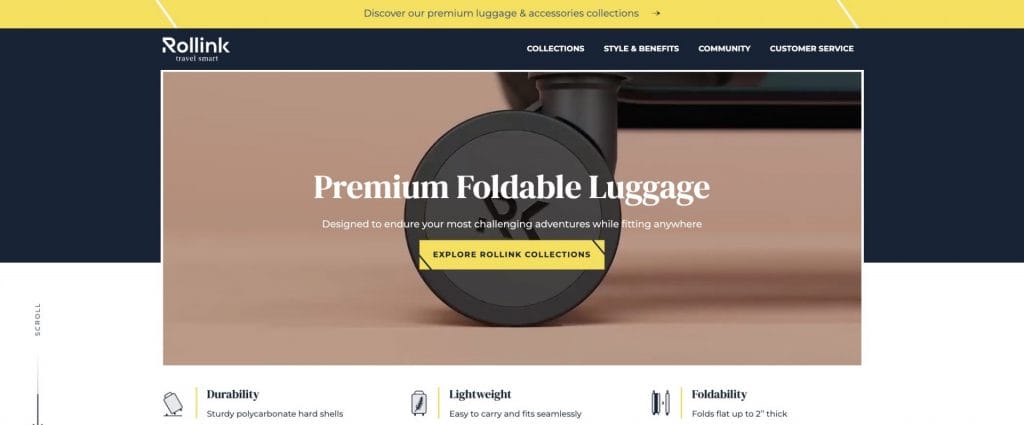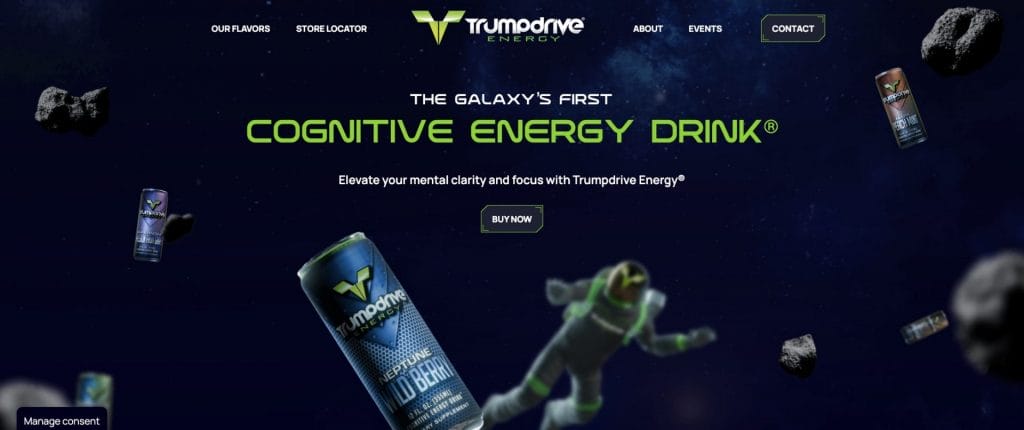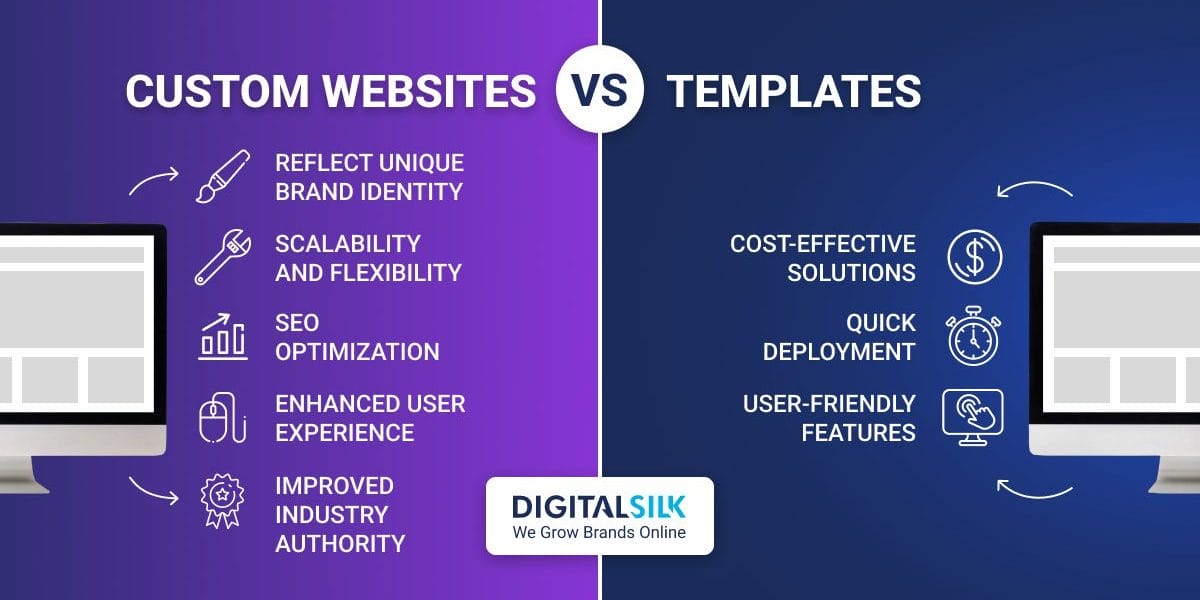Users can form an opinion about a website in as little as 0.5 seconds.
This means it doesn’t take long for someone to decide whether they like a particular page.
As a result, businesses are under more pressure to tick all the boxes on the website design checklist.
At the heart of this strategic process is the dilemma between custom websites vs templates. Both options have their own advantages and challenges but may yield different results.
This post outlines the website templates vs custom design showdown and offers a brief overview of each option’s strengths and potential challenges to help you make the right decision.
Evaluating Custom Web Design
Custom website design involves building a website from the ground up, tailored to match your brand voice and identity, reflect your core messaging and values and resonate with your target demographic.
Given the research-backed strategies and complex methodologies that go into custom web design, the whole process can be broken down into several stages:
- Web strategy: Also known as the discovery phase, this initial stage involves in-depth research and analysis to identify your target audience and relevant pain points, assess your goals and Unique Value Proposition (UVP) and define Key Performance Indicators (KPIs). This stage can also include competitor and market gap research to determine areas for differentiation.
- Planning and information architecture: This stage focuses on outlining the website’s content, developing base-level visual hierarchy, mapping out user flow and creating wireframes for a stripped-down version of your website. During this process, it’s important to highlight consistent and brand-specific messaging that aligns with your brand, effective calls-to-action and intuitive navigation structures.
- Creative design: This phase relies on web design tools to bring your website to life, including strategically positioned website elements, interactive features, on-brand visuals and illustrations and optimized performance and accessibility. With custom web design, you have full control over the images, typography, colors and other visual brand language elements.
- High-performance development: Once you define your website’s user interface (UI) and user experience (UX) requirements, you can translate your design into responsive, fast-loading and cross-device compatible websites. You can gather touchpoint and user behavior data to ensure your website resonates with your target audience and translate mockups into flexible and functional code.
- Quality assurance: Creating the base code and site structure is not enough — you should actively test and troubleshoot your website to minimize downtime and maximize performance. You can use A/B testing to check for bugs, broken links and performance issues, whereas cross-device and cross-browser compatibility testing focuses on replicating real-world user experience scenarios.
- Launch and optimization: When you finalize your custom web design, you can deploy the new site to the live server, configure DNS settings and test the site’s accessibility, functionality and performance. Post-launch, you can receive regular security updates, optimize your site’s speed and performance and add new features and functionalities.
Advantages Of Custom Web Design
So, how does the meticulous process of custom website creation benefit you? How does this phased approach affect the website templates vs custom design debate?
With 38% of users leaving websites with poor design, custom solutions can help you bridge the engagement and retention gap in the following ways:
1. Reflect Unique Brand Identity
75% of visitors assess a brand’s credibility based on its web design.
What would you choose — a cookie-cutter template with few personalization options or a custom site that accurately reflects your brand identity and communicates your values?
Custom web design can help you maintain brand consistency and express your signature persona.
You can tailor every element — including color scheme, typography and graphics — to match your brand, industry and target audience.
Digital Silk’s team analyzed Rollink’s Unique Value Proposition (UVP), target audience pain points and competitive landscape to create a brand-specific, user-friendly and visually appealing website.
The homepage features relevant luggage-related animations, a signature Rollink color palette and on-brand CTAs to entice users to browse more.

2. Scalability
Custom websites offer immense scalability potential.
As your business grows, you can add new features and functionalities, swap out existing sections or add new pages.
You can also incorporate advanced features like chatbots, membership portals or eCommerce integrations to improve user experience and generate more revenue.
For instance, you can add multiple location shipping to accommodate new market expansions, upgrade to a subscription platform for recurring revenue or use floating carts and pop-ups to reduce cart abandonment.
Templates normally have limited customization options and pre-defined layouts, which limits your ability to scale and adapt to changing business needs and market trends.
3. SEO Optimization
Search engines are the starting point for 68% of online experiences.
Custom websites come with clean code and optimized metadata, URLs and on-page content to help you rank higher on search engine results pages (SERPs).
Implementing search engine-friendly elements like page speed, responsive design and keyword optimization can significantly improve your website’s visibility and organic traffic.
Additionally, custom websites give you full control over the backend, so you can easily make necessary changes to keep up with continuously evolving SEO and search engine algorithms.
On the flip side, website templates often feature the same or similar metadata and key components, which may negatively impact your visibility and rankings.
4. Enhanced Functionality And User Experience
Businesses can miss out on 35% of potential revenue as a result of poor user experience.
When you analyze your target demographic’s pain points, browsing behavior and preferences, you can translate that data into a custom website that meets their needs and solves their problems.
Designers can help you build custom functionalities like signature animations, on-brand mega menus and layouts, interactive forms and drag-and-drop features to streamline navigation, improve engagement and ultimately drive conversions.
Moreover, a custom website allows for easy integration with third-party tools and applications, such as payment gateways, CRM systems, social media platforms and email marketing services.
This way, you can optimize your website for lead generation and customer retention, as well as track and analyze user behavior to improve your content marketing strategy.
Digital Silk designed Trumpdrive Energy‘s website to feature a sticky navigation bar so users have easy access to key information, showcase the brand’s products in the animated hero section and offer video testimonials for credibility.

5. Improved Industry Authority
59% of users prefer “beautiful” and “well-designed websites as opposed to simple and plain ones.
A well-designed custom website can help establish your brand as an industry leader and increase consumer trust and loyalty.
Your site is a digital representation of your business, which reflects your professionalism, industry expertise and quality of products or services.
When you show your audience you care about your brand image and online reputation, they’re more likely to trust and engage with your business.
Moreover, a custom design can showcase industry awards, certifications or partnerships to further strengthen your credibility and authority in the eyes of potential customers.
Challenges Of Custom Web Design
Despite their admirable benefits and ROI potential, custom websites have come with a handful of challenges, including:
1. Higher Upfront Costs
The cost of a custom website varies depending on the number of pages required, additional functionalities, complexity and design requirements.
Compared to pre-made templates and themes, custom web design can be a considerable investment for businesses on a tight budget.
However, the long-term benefits of a tailored website can outweigh the upfront costs, as you will save time and resources on constant updates and improvements.
Not to mention the potential for higher conversions and revenue since users easily browse and interact with your content.
2. Longer Development Time
Following the latest web design trends is only the first step towards a custom website.
Once you determine core design elements, it can take anywhere from a few weeks to a few months to develop your website.
Unlike off-the-shelf templates, custom web design requires thorough planning, wireframing, coding and testing to optimize on-page content and functionalities.
Businesses with strict timelines and unforgiving deadlines may not appreciate the longer wait time.
3. Resource-Intensive Solution
The web design industry boasts a market share of $43.5 billion in the U.S. alone, which translates to intense competition and constant innovation.
Delivering a responsive and pixel-perfect website requires a team of skilled professionals, including web designers, developers, SEO specialists and content creators.
Besides the expertise, creating a custom website also demands time and financial resources for research, prototyping tools and design software.
Evaluating Website Templates
The second contender in the custom website design vs theme debate is a ready-made website template with several convenient benefits and notable drawbacks.
Advantages Of Website Templates
As pre-designed website layouts with standardized features, website templates offer the following advantages:
1. Cost-Effective Solutions
Businesses with limited budgets and resources can benefit from affordable website templates.
You can browse websites like TemplateMonster or ThemeForest to filter budget-friendly options based on the platform you’re using, such as WordPress, Shopify or WooCommerce.

Even WordPress offers platform-specific themes — both free and paid — under different categories and industries.

2. Quick Deployment
Since there’s no need for back-and-forth communication with designers and developers, you can quickly get your site up and running by filling in brand-specific details.
You don’t need extensive technical knowledge or coding skills to set up and launch your website, which can save some valuable time and effort.
This is particularly useful for time-sensitive or seasonal campaigns — such as holiday sales or product launches — where you need a functional website quickly and for a limited period.
3. User-Friendly Features
Templates come with built-in core functionalities, such as navigation bars, contact forms and image galleries, which eliminates the need for additional coding or plugin integration.
Most of them have drag-and-drop interfaces and visual editors, so you can easily make changes to the stock design without affecting the website’s functionality.
Moreover, pre-designed templates follow a standard set of best practices for user experience and conversion optimization, which also saves time on UI/UX testing and tweaking.
Challenges Of Website Templates
Despite the apparent convenience and time-saving benefits templates offer, they do fall short in several crucial areas, including:
1. Limited Customization Options
60% of consumers value usability on websites, which is directly impacted by customization features and brand-specific elements.
If you copy-paste the design and branding elements as other businesses with the same template, you risk blending in with competitors and losing your brand’s Unique Selling Point (USP).
Despite the extensive theme library available, there’s only so much you can do to make a generic design fit your brand requirements, resonate with your target audience and improve market authority.
2. Potential SEO Drawbacks
Performance issues and code bloat are two common SEO pitfalls of website templates.
Search engine algorithms prioritize websites with high loading speeds, well-written code and user-friendly navigation, which is not always achievable with a pre-designed theme.
Not to mention the limited SEO customizations and the potential for duplicate content across websites using the same template, which can significantly hinder your search engine rankings.
3. Scalability Issues
Due to the fixed structure of ready-made templates, you may find it challenging to add new features, pages, or functionalities as your business grows.
Upgrading to a more advanced template may not always be feasible or cost-effective and you may ultimately require a custom website to accommodate your expanding business needs.
4. Relying On Template Providers
Regardless of the source, using a website template means relying on the provider for updates, bug fixes and security patches.
If the provider goes out of business or discontinues support for your chosen template, you could be left with a vulnerable website and no access to technical support.
Custom Website Or Template: Which One To Choose?
After evaluating both options, consider the following factors to determine which is more appropriate for your business:
- Brand identity alignment and requirements: How well does either option fit your core messaging and visual brand language? What visual elements do you prioritize so they align with your long-term goals and values? If a template imposes too many restrictions, a custom website might be the better option.
- User interface and personalization: What features does your target audience expect from your website? Would you need to modify the template’s structure extensively to meet these needs? Or is a more in-depth approach necessary to meet consumers’ needs?
- Time constraints: How quickly do you need to launch your website? Can you sacrifice a few weeks in favor of a more tailored solution? If you’re on a tight deadline, using a template could save you valuable time.
- Budget: Can your budget accommodate the costs associated with building a custom website? Even with the expected Return on Investment (ROI), is this a sustainable and feasible investment for your business at this moment? If not, a template may be a more cost-effective solution.
- Scalability and flexibility: Even if a particular theme meets your current business needs, do you expect significant business growth in the future that might render it inadequate? How prepared are you for changes in the market or user behavior? A custom website can adapt to these changes, but a template may not have the same flexibility.
- Performance and SEO goals: With advertising spending amassing $360 billion in the U.S. alone, how much of your marketing efforts rely on search engine visibility? While templates are usually optimized for SEO, a custom website can offer more control and customization to boost search engine rankings.
Design A Custom Website With Digital Silk
Designing a custom website is a long-term and strategic investment that most businesses don’t take lightly.
It requires thorough planning, market analysis and target audience segmentation to determine the website’s functionality, design elements and user experience.
At Digital Silk, our experienced team of web designers and developers work closely with our branding and digital strategists to deliver high-performing, brand-specific and conversion-focused websites.
As a recognized web design company, our services include:
Have an idea for a custom website?
Contact our team, call us at (800) 206-9413 or fill in the Request a Quote form below to schedule a consultation.
"*" indicates required fields



